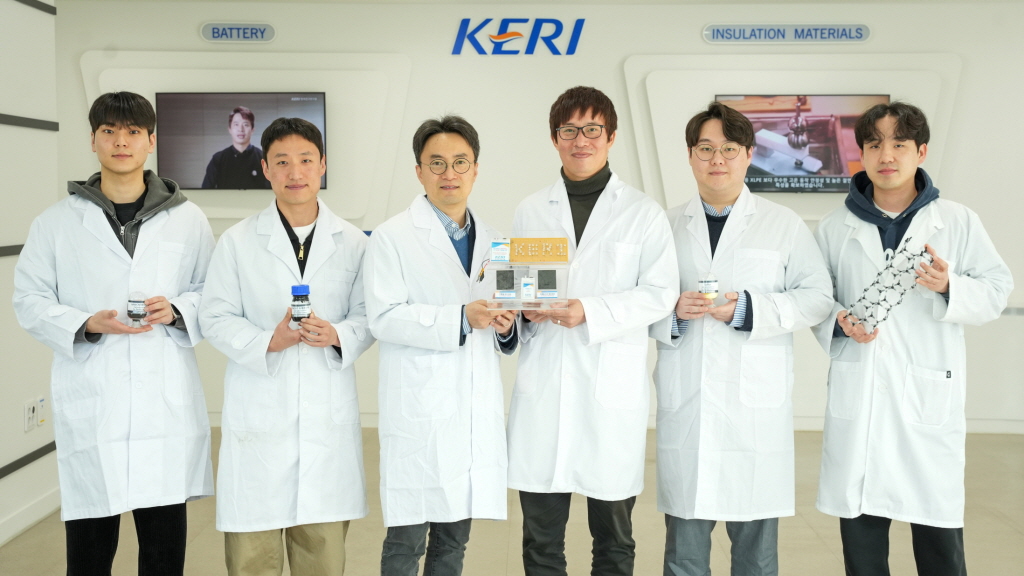한국전기연구원(KERI) 차세대전지연구센터 박준우 박사팀이 차세대 리튬황전지의 상용화를 막던 ‘리튬폴리설파이드’ 용출 억제에 성공하고, 대면적·고용량 시제품까지 만드는 데 성공하며, 도시형 항공 모빌리티(UAM) 분야와 전기차, 항공 우주 등 다양한 산업에서 커다란 혁신을 가져올 것으로 기대된다.

▲이번 연구를 진행한 KERI 박준우(왼쪽 4번째) 박사팀
‘리튬폴리설파이드’ 용출 억제 성공
한국전기연구원(KERI)이 차세대 리튬황전지의 상용화를 막던 난제를 극복하고, 대면적·고용량 시제품까지 만드는 데 성공하며, 도시형 항공 모빌리티(UAM) 분야와 전기차, 항공 우주 등 다양한 산업에서 커다란 혁신을 가져올 것으로 기대된다.
KERI는 차세대전지연구센터 박준우 박사팀이 탄소나노튜브 및 산소 작용기로 ‘리튬폴리설파이드’ 용출 억제에 성공했다고 20일 밝혔다.
리튬황전지는 양극으로 황을, 음극으로 리튬 금속을 사용해 기존 리튬이온전지에 비해 이론적인 에너지 밀도가 8배 이상 높다.
게다가 희소한 자원을 사용하지 않고 가격이 저렴해 환경 친화적인 이차전지로 주목받고 있다.
반면에 충·방전 과정에서 리튬폴리설파이드라는 중간 물질이 생성돼 전지의 수명과 성능을 저하시켜 상용화에 큰 걸림돌이 돼 왔다.
박준우 박사팀은 이 문제를 해결하기 위해 단일벽 탄소나노튜브(SWCNT)와 산소 작용기를 결합한 신기술을 개발했다.
SWCNT는 강철보다 강하고 전기 전도성이 뛰어난 신소재로, 산소 작용기는 이 물질이 전지 내부의 다른 물질에 잘 분산될 수 있게 한다.
이를 통해 전극의 안정성을 높이고 리튬폴리설파이드의 용출 및 확산을 효과적으로 제어해 활물질인 황의 손실을 줄이는 데 성공했다.
이 기술을 통해 연구팀은 50x60㎜ 크기의 유연한 후막 전극을 제작할 수 있었고, 이를 적층하여 1,000㎃h(1Ah)급 파우치형 리튬황전지 시제품을 제작했다.
이 시제품은 100회 충·방전 후에도 용량의 85% 이상을 유지하는 우수한 성능을 자랑한다.
박준우 박사는 “이번 성과는 리튬황전지 상용화를 가로막던 큰 난제를 해결한 것뿐만 아니라, 실제 산업 현장에 적용 가능한 기초 틀을 마련했다는 점에서 큰 의의가 있다”고 말했다.
연구 결과는 재료과학 분야의 세계적인 저널 ‘어드밴스드 사이언스(Advanced Science)’에 게재됐으며, 논문 영향력 지수(Impact Factor)는 14.3으로 상위 7.18%에 해당한다.
한국전기연구원은 이번 성과를 바탕으로 도심형 항공 모빌리티, 항공·우주, ESS, 전기차 산업 등 차세대 리튬황전지가 필요한 기업들과 기술이전을 추진할 계획이다.
이번 연구는 과학기술정보통신부의 국가과학기술연구회 산하 연구기관으로, 글로벌 탑 전략연구단 사업 및 기본사업으로 진행됐다.
